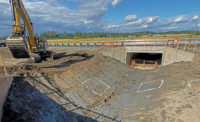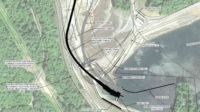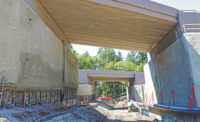The biggest beneficiary of the largest federal stimulus project by the U.S. Dept. of the Interior is a fish.
Two fish, actually – green sturgeon and Chinook salmon, the migratory habits of which are at the center of a $230-million Fish Passage Improvement Project at the Red Bluff Diversion Dam in Red Bluff, south of Redding.
The National Oceanic and Atmospheric Administration ruled last year that the dam’s gates threaten the long-term survival of the fish, and so the government is shelling out more than a quarter-billion dollars to lend the creatures’ spawning rituals a hand.
About $109 million of the money comes from the American Recovery and Reinvestment Act, and $21.4 million of that was just awarded by the Bureau of Reclamation Mid-Pacific Region to West Bay Builders of Novato to build phase one of the two-phase project.
West Bay is charged with building a bridge over Red Bank Creek to connect an existing operation and maintenance facility to a pumping plant, which will be built in the second phase by Balfour Beatty Infrastructure of Fairfield. West Bay will also construct channels to move water from the new pumping plant to the headworks of the Tehama-Colusa and Corning canals.
“The project as a whole is called a fish screen,” says Chris Van Tiem, project manager for West Bay Builders. “It’s a concrete structure in the middle of the Sacramento River that allows water to go through, but no fish. Water is pumped up about 20 ft and dispersed into a canal. It goes through one canal for about 400 ft and into an underground concrete siphon and takes it under Red Bank Creek.”
Eventually, the water is dispersed into the Tehama-Colusa Canal and carried down to irrigate the croplands of Tehama, Glenn, Colusa and northern Yolo counties.
U.S. Secretary of the Interior Ken Salazar was on hand for the project’s groundbreaking ceremony in March. In fact, Salazar and Bureau of Reclamation Commissioner Mike Connor picked up shovels and broke the ground themselves. The Fish Passage Improvement Project is billed as the Dept. of the Interior’s largest economic-stimulus project.
Riverside-headquartered CH2M Hill is the project engineer.
All this might seem like a lot of trouble to go through just to help a few fish, but it’s not just a few fish. According to a press release last year by NOAA, “What is at stake here is not just the survival of species but the health of entire ecosystems and the economies that depend on them.”
The fish were reportedly doing just fine until the Red Bluff Diversion Dam and its 11 60-ft gates were plopped smack in the middle of the Sacramento River tributary in the mid-1960s.
“The dam looks like a big bridge, with gates that go up and down like a garage door,” says Bureau of Reclamation spokesman Pedro Lucero. “When the gates are up, the river flows freely and there’s zero environmental impact – it’s more like a bridge. When you lower the gates, it creates a small backwater behind it, raising the level of the river about 10 to 12 ft and allowing for gravity to flow water into canals and adding about $1 billion to the regional economy in agricultural benefits.
“When those gates are down, they have the environmental impact of hampering the ability of the fish to migrate to their prime spawning grounds beyond the dam. Also, you have juvenile fish getting disoriented under the gates, which become a prime place for predation.”
During construction of the Fish Passage Improvement Project, interim pumps will temporarily resolve the threat to the fish by raising the lake water and channeling it into the canals between September and June, allowing the dam gates to stay raised during the fishes’ prime migratory season.
The problem should be solved permanently when Balfour Beatty completes the second phase of the project.
The Bureau of Reclamation awarded the company a $67-million contract to build the pumping station, installing nine pumps and motors and an electrical switchyard. When that work is finished in September 2012, the diversion dam’s gates will be rendered obsolete and remain permanently open.
Work on the second phase is expected to begin within the next month.
“This has been a project that has brought together a lot of disparate interests – environmentalists, the business community and bipartisan support on the state and federal level,” says Jeff Sutton, general manager of the Tehama-Colusa Canal Authority, which is overseeing the project in partnership with the Bureau of Reclamation Mid-Pacific Region. “It has been a win-win situation on all levels – one that really addresses environmental responsibility and economic sustainability.”
div id="articleExtras"







Post a comment to this article
Report Abusive Comment